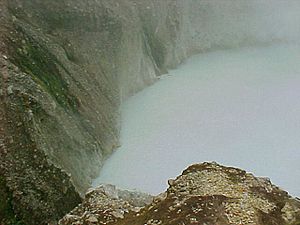Boiling point facts for kids

The boiling point of a substance is the temperature at which it starts to boil rapidly. When a liquid boils, it changes into a gas. This process is called evaporation. For pure water, the boiling point is 100° Celsius (212° Fahrenheit). This measurement is usually taken at a normal air pressure, like the pressure at sea level.
Contents
What is Boiling Point?
Imagine heating a pot of water on a stove. As the water gets hotter, you'll start to see bubbles forming. These bubbles are water turning into a gas (steam). When the water reaches its boiling point, these bubbles form very quickly throughout the liquid and rise to the surface. This is when the water is truly boiling.
The boiling point is a specific temperature for each pure substance. It tells us when a liquid will change into a gas under normal conditions. This temperature is important in cooking, science, and many other areas.
How Pressure Changes Boiling Point
The air around us pushes down on everything. This push is called pressure. The boiling point of a liquid can change depending on how much pressure is pushing on it.
If the air pressure increases, the boiling point goes up. This means the liquid needs to get even hotter to boil. If the air pressure decreases, the boiling point goes down. This means the liquid will boil at a cooler temperature.
Boiling at High Altitudes
Think about climbing a very tall mountain, like Mount Everest. At the top of such a high mountain, there is much less air pushing down. This means the air pressure is much lower than at sea level. Because of this lower pressure, water boils at a much lower temperature. For example, on Mount Everest, water boils at only about 69°C (156.2°F). This is why it's harder to cook food properly by boiling on a high mountain!
The boiling point is also the temperature where the liquid's "vapour pressure" becomes equal to the surrounding air pressure. Vapour pressure is the pressure created by the gas particles escaping from the liquid.
How Other Substances Change Boiling Point
Adding other substances to a liquid can also change its boiling point. These added substances are called solutes.
What are Solutes?
A solute is something that dissolves in a liquid. For example, when you add salt to water, the salt dissolves. The salt is the solute, and the water is the solvent.
Adding Salt or Sugar
If you add things like sugar or salt to water, they usually make the boiling point higher. This means the water will need to get hotter than 100°C before it starts to boil. This is why some recipes suggest adding salt to water before boiling pasta; it allows the water to get slightly hotter.
Adding Alcohol
On the other hand, some substances can lower the boiling point. For example, alcohol is a "volatile" chemical. This means it evaporates easily. If you mix alcohol with water, it will usually make the boiling point of the mixture lower. Even a small amount of alcohol can cause a slight change in the boiling point.
See also
 In Spanish: Punto de ebullición para niños
In Spanish: Punto de ebullición para niños

